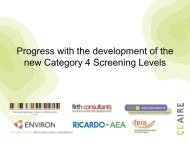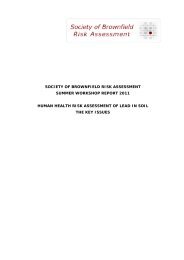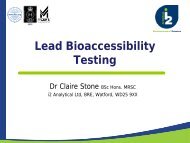Contaminated Land - SoBRA
Contaminated Land - SoBRA
Contaminated Land - SoBRA
Create successful ePaper yourself
Turn your PDF publications into a flip-book with our unique Google optimized e-Paper software.
Force Crag mine<br />
Peter Bardsley<br />
North Area Operations<br />
Technical Lead –<br />
Mines & Minewater<br />
01768 215727
Soil Leaching data
Background<br />
Force Crag mine, near Keswick, was worked<br />
for lead, zinc and barytes from 1835 until 1991<br />
owned by the National Trust<br />
Lake District High Fells SAC;<br />
and within two SSSIs: the Force Crag Mine itself<br />
and Butttermere High Fells.<br />
Scheduled Ancient monument.
Background<br />
Major source of heavy metal pollution in the<br />
Coledale Beck, a tributary of the Newlands<br />
Beck and the River Derwent & Bassenthwaite<br />
Lake Special area of Conservation (SAC)&<br />
Site of Special Scientific Interest (SSSI).
Impact of discharge<br />
Cadmium 17 ug/l<br />
Load of zinc discharged per annum up to 3<br />
tonnes
Current situation<br />
There are two minewater discharges, as well<br />
as diffuse pollution from waste heaps and old<br />
tailing lagoons at the mine. This results in high<br />
levels of metals,: lead, zinc, copper and<br />
cadmium,<br />
Adit 0 is partially blocked causing a head of<br />
water to build up in the mine
Water filled Crown hole above adit 0
Entec study 2008<br />
The Coledale Beck and the Newlands Beck in<br />
Braithwaite both fail their environmental quality<br />
standards (EQS) for zinc and cadmium.<br />
Immediately downstream of the mine the zinc and<br />
cadmium concentrations are up to 140 and 65 times<br />
the standard respectively.<br />
Five kilometres downstream of the mine in the<br />
Newlands Beck, zinc is seven times the EQS and<br />
cadmium four times.
Regulations & Control<br />
Water Resources Act<br />
Environmental Protection Act 1990 , Part 2A<br />
<strong>Contaminated</strong> land<br />
Water Framework Directive<br />
Mining Waste Directive
Mining waste Directive – Article 20<br />
we must produce 'an inventory of closed waste facilities, including<br />
abandoned waste facilities, which cause serious negative<br />
environmental impacts or have the potential of becoming, in the<br />
medium or short term, a serious threat to human health or the<br />
environment.‘<br />
The directive isn’t concerned with the impacts from mine 'workings' (ie<br />
shafts, addits, tunnels etc.) but only the mine waste facility.<br />
A mine waste facility is a tailings dam, tailing lagoon, tailings tip, waste<br />
rock dumps or spoil heap. These must be having an impact, or have<br />
the potential to have an impact, on the environment.The potential to<br />
have an impact should be over the next 5 to 10 years.
Water Framework Directive<br />
Ecological characteristics<br />
Chemical characteristics<br />
“good chemical and ecological status”<br />
Exceedence of Environmental Quality<br />
Standards affects status<br />
6 yearly cycle -2012 programme of measures<br />
2015 meet objectives good status
The problem<br />
9% river failing “good status”<br />
226 water bodies impacted by non-coal mining<br />
243 water bodies probably impacted<br />
WFD River basin management plans<br />
£370 million over 10 years plus operating<br />
costs (90% minewater,10% risk outbreak)
Water Resources Act<br />
S. 161 Works notice<br />
S85 pollution offence<br />
Abandonment 1998 plans
Minewater /mine
Most of the time the main minewater discharge<br />
contributes up to 90% of the site's metal load.<br />
At times of high flow a significant contribution<br />
(80%) arises from run off & seepage from<br />
diffuse sources such as the settlement lagoon<br />
and mine waste heaps.<br />
Force Crag mine contributes up to 70% of the<br />
total load of metals in the Newlands Beck.
Resolving the impoundment<br />
Grave environmental issue, would result in a<br />
major pollution incident in a sensitive area.<br />
National Trust have investigated methods of<br />
relieving the pressure behind the blockage to<br />
allow the minewater to drain safely<br />
NT concerned over liability/ownership issues<br />
and permitting requirements
Minewater Treatment<br />
The 'passive' treatment requires a pilot scale<br />
plant at the site before a full-scale system can<br />
be designed and built. Pilot plant now built<br />
Hydrometric installations require continued flow<br />
and quality monitoring.<br />
Drill to intercept water-filled tunnel and dewater<br />
– vertical & inclined drilling<br />
Ground Investigation for design of treatment
Potential Special Site –Regulation 3(b)<br />
<strong>Contaminated</strong> <strong>Land</strong> (England) Regulations<br />
2006<br />
“Controlled Waters are being affected by the<br />
land and, as a result, those waters do not meet<br />
or are not likely to meet the criterion for<br />
classification applying to the relevant<br />
description of waters specified in regulations<br />
made under section 82 of the Water<br />
Resources Act 1991 (classification of waters)”
Inspection -Statutory Guidance (Defra<br />
Circular 01/2006)<br />
B.20(a) Desk study<br />
B.20 (b) Visual inspection /limited sampling
guidance<br />
EA technical advice to 3 rd parties on pollution<br />
Controlled Waters fro part IIA (2002)<br />
Water Framework Directive – River basin<br />
Districts Typology,Standards and Groundwater<br />
Threshold Values (WFD) Directions 2010
Is there Pollution of Controlled Waters<br />
Poisonous,noxious or polluting matter or any<br />
solid matter…<br />
Breaches of EQS..is the pollution significant<br />
Since old EQS have not been revoked yet,<br />
compare site data with old and new Defra<br />
Directions (future proof)
S82 Water Resources Act 1991<br />
The Surface Waters (fishlife) (classification)<br />
Regs 1997 -95%tile<br />
The Surface Waters (River Ecosystem)<br />
(Classification) Regs 1994
Breach of WFD Directions standards<br />
Reg 3(b) Special Site does not mention WFD<br />
Currently, 3(b) applies when a site fails an EQS at a<br />
compliance point set under appropriate regulations<br />
Changes to monitoring network focus on WFD and<br />
many compliance points have been removed.. No<br />
compliance point means we cant demonstrate a<br />
failure to meet an environmental quality standard.<br />
Dangerous substance compliance (Reg 3(b))is at any<br />
point along the stretch
2011 Leaching data<br />
Lead EQS 7.2 ug/l<br />
min.0.156 mean 1106, max. 13900<br />
Copper EQS 1ug/l<br />
Min.
surface water quality -<br />
Assess contribution from diffuse source as<br />
opposed to accumulative minewater and<br />
diffuse source.<br />
Flow regime proportion low-medium –high.<br />
Diffuse pollution accounts for up to 80% load<br />
under high flow
Metal GAC (µg/l) Magnitude of Exceedance of EQS<br />
Leaching Tests on<br />
Spoil/Mine<br />
Waste/Tailings<br />
Lagoons<br />
Drainage/Standing<br />
Water from Spoil/Mine<br />
Waste/Tailings<br />
Lagoons<br />
Coledale Beck<br />
Downstream of Force<br />
Crag Mine Location A<br />
(contribution from<br />
diffuse sources under<br />
wet conditions)<br />
Barium 1000 (DWS) None × 1 No data<br />
Cadmium 0.08 (EQS) × 3-7875 × 6-245 × 1-18<br />
Copper 1 (EQS) × 1-104 × 1-8 × 1-1.4<br />
Lead 7.2 (EQS) × 2-1931 × 3-63 × 1.4<br />
Manganese 50 (DWS) × 1-788 × 1-52 None<br />
Zinc 8 (EQS) × 1-7937 × 12-723 × 2-37
Special Site Status<br />
For cadmium (Dangerous Substance)–<br />
The surface Waters (Dangerous Substances)<br />
(Classification)1989,no.2286 – this relates to the<br />
whole stretch rather than a monitoring point<br />
Cd standard 5ug/l (total & dissolved and is an annual<br />
average.<br />
Need to show diffuse pollution causes annual average<br />
failure at any point in the watercourse.
Determination decision<br />
Meets criteria for determination as<br />
contaminated land (Section 78A(2)(b) Part 2A<br />
Environmental Protection Act 1990) due to<br />
pollution of Controlled Waters caused by<br />
copper, lead and zinc entering Coledale Beck
Determination Status<br />
<strong>Contaminated</strong> land= yes<br />
Sources identified - Level 3 gully as significant source<br />
during wet conditions- standing water and seepage<br />
exceed EQS<br />
Special Site =no<br />
Exceedence at Newlands Bridge Cu and Zn during<br />
wet weather only- It does not constitute to a 95 th<br />
percentile failure<br />
Cadmium (annual average) concentrations not<br />
significant given overall flow regime.
Way Forward<br />
Combined pot £4.53 million – contaminated<br />
land capital projects in UK<br />
WFD £110 million over next 4 years non-coal<br />
mines<br />
October 19 the Energy Act received royal<br />
assent giving the Coal Authority new powers to<br />
take action in subsidence or water pollution<br />
issues at sites other than coal mines.<br />
Working in Partnership with National Trust
Objective Objectives<br />
SPL confirmed -water quality improvement<br />
required.<br />
EA asked LA to delay determination<br />
This will allow voluntary solution<br />
Not process driven<br />
Funding partnership (not from CL pot)<br />
Working together<br />
LA have more power to steer remediation –<br />
Can determine at any time
Costs and benefits of remediation<br />
Pilot plant cost £28k . full treatment option<br />
£1million<br />
Bassenthwaite Lake SSSI would be protected<br />
from a major pollution source<br />
The river corridor in a SAC would be improved<br />
The Newlands Beck would be better able to<br />
achieve good ecological status<br />
Ecological improvements would be made to 5<br />
km of good quality habitat
Possible Remediation of <strong>Land</strong><br />
<strong>Contaminated</strong><br />
Diffuse sources of pollution from mine spoil<br />
addressed by intercepting & diverting clean sw<br />
capturing run-off from waste spoil heaps into<br />
treatment facility.<br />
The base liner of the treatment lagoons could<br />
also act as a cap, on the existing lagoon.<br />
Other work -Force Crag is not the only source<br />
of metals contributing to the failure of the<br />
Newlands Beck. Need investigations in<br />
Newlands valley
Conclusion<br />
Mine sites can be complex<br />
Proportionate assessment of impact is required<br />
Data supports SPL sufficient to determine site<br />
as contaminated land<br />
Significance does not warrant Special Status<br />
Working in partnership to improve water quality<br />
Treatment technology and remediation to be<br />
agreed.






